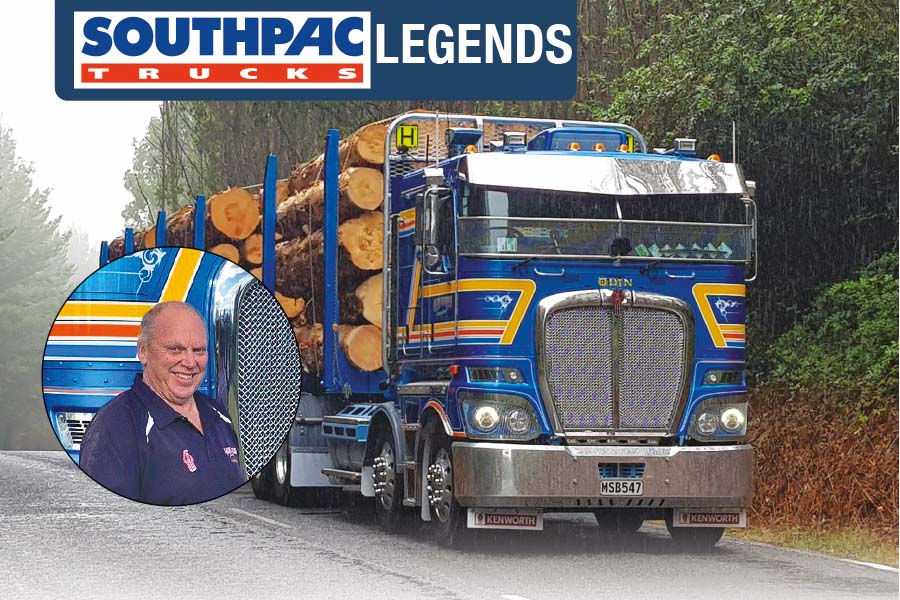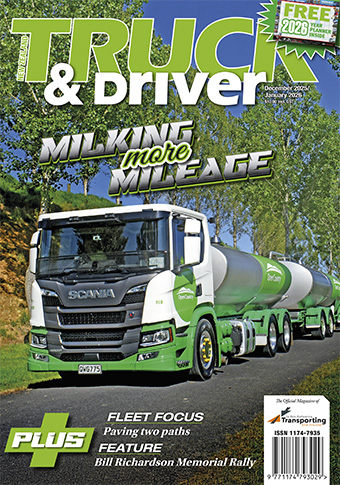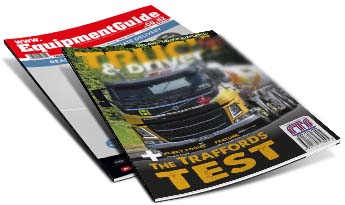Southpac Legends


Growth and Learning – Alan Forbes
Southpac Legends
If you’ve spent any time around the Tokoroa region and the forestry industry, Alan Forbes is a name you’ll be familiar with.
Not only did this Southpac Legend grow a large and successful log transport business from humble beginnings, but he was also there when the LTSC (Log Transport Safety Council) was formed and continues to ‘learn’ with the TOL (Tour of Learning) group.
As with many transport operators Alan developed a keen interest in trucks through his father. As a young fella, he used to go to work with his dad, going out with the trucks and helping with the material handling.
“I just liked machinery and trucks so I used to go work with him on a Saturday, and that kindled the interest,” says Alan.
Alan’s father was transferred from Whakatane to Kinleith Mill and was managing the workshops, so Alan got an apprenticeship at the mill and did his time there. But it was the work with their trucks that really piqued his interest.
...If you’ve spent any time around the Tokoroa region and the forestry industry, Alan Forbes is a name you’ll be familiar with.
Not only did this Southpac Legend grow a large and successful log transport business from humble beginnings, but he was also there when the LTSC (Log Transport Safety Council) was formed and continues to ‘learn’ with the TOL (Tour of Learning) group.
As with many transport operators Alan developed a keen interest in trucks through his father. As a young fella, he used to go to work with his dad, going out with the trucks and helping with the material handling.
“I just liked machinery and trucks so I used to go work with him on a Saturday, and that kindled the interest,” says Alan.
Alan’s father was transferred from Whakatane to Kinleith Mill and was managing the workshops, so Alan got an apprenticeship at the mill and did his time there. But it was the work with their trucks that really piqued his interest.
“I served my time at NZ Forest Products in Kinleith, in the Tokoroa workshops. They had a fleet of logging trucks there, and that sort of got me going.”
Finishing his apprenticeship, Alan got a job at what was then known as Alexander Grain and worked for John Alexander for the subsequent 12 months in the workshop. He also ended up doing quite a bit of driving there too.
“That’s what started me off,” he says.
From there he went back to Tokoroa and started driving for Forest Products, in a company truck.
“After 12 months they offered me a position as a contractor on a self-loading truck. It had a crane on the back and I had to load myself and away we went. That was 1979.”
Alan’s first truck was a K124 cabover Kenworth. It was only a six-wheeler, but Alan says it was all off highway work that he was doing. The K124 was brand new too, which in many ways was a big punt, and its purchase is something that Alan recalls vividly.
“I remember my accountant having an argument with one of the forestry distribution managers at Kinleith. The distribution manager wanted me to buy a TM Bedford but my accountant told him ‘if this young fella [me] goes broke, I want a truck that he can sell’.”
Alan says this was back in the days when you couldn’t cart against the rail, so he had to apply for an area licence, and go to court to show it was financially viable.
“I hadn’t been going that long when they opened everything up. So it’s a bit of a breeze nowadays.”
As it turned out, Alan had only been in business a few months when in 1980 there was a big strike at Kinleith. He says it was a tough time and when it was over he essentially had to start again.
“But there’s always been something like that, you think you’re getting on top of things and something out of the blue happens and the money all goes. But that’s trucking I guess,” he reflects.
Alan ran as a contractor at Kinleith from 1979 to 2021 and it was almost 42 years to the day when he sold his business.
“I saw a lot of owners and a lot of managers, we had some good ones and we had some bad ones. But quite often with the bad ones we still made quite a bit of money out of them. It was crazy times some years and tough times too. But we survived.”
Alan also survived the time that Kinleith went from around 40 contractors down to nine or 10, saying that he was one of the lucky ones that was picked.
“Then a few of the owner drivers came and worked for me and I slowly bought them out when they wanted to exit the industry. It worked for both of us, otherwise I would have had to spend a whole lot of money on trucks and it used to keep them in a job. I expanded and never looked back,” he says.
He adds that all the owner drivers he had were “bloody excellent” and he still had one owner driver (Steve Livingstone) when he sold.
Aside from owner operators, Alan started a fair amount of people off into the industry too. He took on a number of drivers that only had a Class 4 and got them up to speed. He says, “you’ve just got to have the patience and the time, and be prepared to absorb that unproductive time.”
He believes most of his new drivers turned out to be good.
Overall, it seems like Alan has been fairly content with the drivers he’s worked with, and despite their ebbs and flows, has managed to create a very loyal workforce.
“We had quite a few guys leave and come back, one came back twice and another came back three times. When I left we had three guys with over 20 years with us, and a number with well over 10 years.”
Alan stepped out of full time driving around 1997, but still used to drive “when needed.”
He moved into the office to focus more on the operations.
“As we grew, it got too big for Mark Barrett running the workshop and the office, so he took over the workshop and Brent Hamley came off the trucks to manage the dispatching. He’s still there today, managing Gilmour Transport.
“Karen along with Shar and Michelle covered the administration, health and safety and always had our back.”
It was around this time that Alan helped form the LTSC. He says that the government was threatening to take log trailers away due to rollovers.
“If we didn’t self-regulate they were going to regulate for us and I don’t think we would have liked the outcome [hence the LTSC formation]. But now we’re up to 5-axle trailers, lower and longer - the logging industry has done itself pretty proud.”
At the height of his business, Forbes had a total staff count including the workshop and office of about 25. When he sold the fleet comprised about 20 trucks, all Kenworths.
“When I took these owner drivers on I inherited a whole lot of bits and pieces - Macks and things. I even bought a couple of DAFs but they didn’t quite work out so I went back to being 100% Kenworth. The guys in the workshop know where they are, all the filters are the same, and the gearboxes, diffs, it just worked out better.”
Gilmour Transport [50% Warwick Wilshier/ 50% Campbell Gilmour] took over the business on June 1 2021 and most of the staff have stayed on. Gilmour Transport has just built a new workshop in Tokoroa that they’re about to move into.
“I’m happy they’ve gone to such a good outfit.”
It’s not all been plain sailing though, and aside from the financial challenges, Alan also had a fatality in his team.
“We lost a driver in an incident while loading in Napier. This was by far the hardest thing we have ever faced in business. He was not only an employee but also a family friend.”
Conversely some of Alan’s best moments he’s had within the industry are around the guys he’s met, from fellow contractors to sales people. “We’ve got some good relationships, we catch up and have a chat,” he says.
In fact he does much more than that. He says there’s a group of contractors and associated guys that call themselves ‘The Tour of Learning’ or TOL. They go on trips both in NZ and across the ditch to look at machinery and businesses.
“The TOL started back around 2010. We have a look at different gear, go to truck shows - we’re going to Wheels in Wanaka next year.
“Among the group there’s Goose Haddock from Haddock Spray Painters and Willie Malcolm of Malcolm Cab Solutions. There’s a lot of learning and there’s a bit of drinking involved too. Warwick Wilshier often says other sectors of the industry can’t believe we get on so well and yet we’re competitors.”
Alan says that TOL began as an offshoot from a Melbourne Truck Show trip they all attended and it carried on from there.
“Nowadays one of our old distribution managers Bruce Nairn organises it all while Peter Withington handles the finances.
“We have so much fun together, it’s great. We’ll be doing it until we die. I just love trucking, trying different things and where the industry has led.”
When Alan turned 66, the offer came along to buy his business and he accepted.
“I thought I could do another few years but Karen, my wife, was keen to sell and pointed out it was too good an opportunity to pass up. I’ve had no regrets to be honest.
“I do miss the contact with the guys, but whenever we’re around the yard we’re always calling in to say good day. And they still ring me occasionally to ask for history on different things.”
As far as the future goes, Alan feels like the industry is in pretty good shape the way it is.
“The way everything is set up now it accommodates most log lengths. It’s just the price of everything now is getting out of hand. The trucks, the trailers and availability. I don’t miss any of that. It is a tough industry but I guess you always seem to find a way to make it happen.”
Alan may be ‘retired’ but he’s still doing a bit of quarry work for Swaps – “just something to do,” he says. “It was going to be three days a week but now it’s five some weeks.”
And aside from evidently still working, Alan has plenty of toys to keep him busy including four classic cars (a ‘67 Chevy pickup, ‘60 Impala coupe, a ‘67 coupe and an old Torana) and a boat “that doesn’t get used enough.”
“I’ve also got an old V8 Kenworth that used to belong to Gordon Richards in Tokoroa. We’ve tidied it up and painted it. And I’ve recently bought one of my old trucks back - a ‘98 T900. So, now I’m in the process of building a new shed.”



 + EQUIPMENT GUIDE - FREE
+ EQUIPMENT GUIDE - FREE
